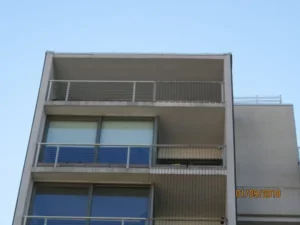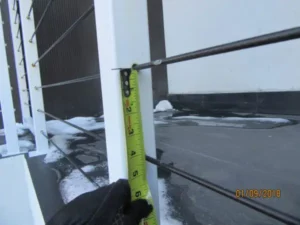
Balcony railings can be seen all over New York City. Typically found on residential buildings, railings are almost always exposed to heavy winds and freeze-thaw cycles. To ensure safety of residents, prevent accidents, and comply with code and Façade Inspection and Safety Program (FISP) requirements, building owners should regularly monitor and maintain balcony railings.
The New York City Department of Buildings’ (DOB) minimum code required height for balcony railings is 42 inches, with an allowance of one inch. Balcony railings below 42 inches are also considered a SWARMP (Safe With a Repair and Maintenance Program) condition in FISP (formerly Local Law 11) reports. Building management should be aware of residents applying flooring treatments to their balconies since this typically decreases the railing heights.
There are several ways of testing balcony railings. Pull tests can be performed at the railing anchors and a testing apparatus can be used to apply specified loads along the railing. According to the New York City Building Code, a railing must withstand a 200-point load in any direction. This means that if a localized or concentrated load of 200lbs was applied to any location on the railing, little to no deflection would result. The code also requires that a railing withstands a 50lbs per foot uniform load; this means that if a load of 50lbs was applied along the entire length of the balcony, there would be little to no deflection in the railing.

The DOB also requires that vertical or horizontal openings between the balusters should not exceed four inches to prevent small children or animals from falling through the railing system. Typically, the width of openings in a rigid post-railing system does not change. However, cables in the recently popular cable railing systems tend to loosen over time, which can result in openings that exceed the four inch requirement. Building management should regularly monitor the condition of the cables in these types of railing systems.
Balcony railings should also be regularly inspected for loose fasteners, peeling paint, and corrosion. Railing posts that are set in concrete slabs should be monitored to ensure that the sealant is intact. If the sealant fails, the grout surrounding the posts is exposed to moisture and will deteriorate. This failure could eventually lead to the dangerous loosening of the post. As mentioned above, implementing a regular monitoring and maintenance program can help address these issues that often cause more costly future repairs and create unsafe conditions.